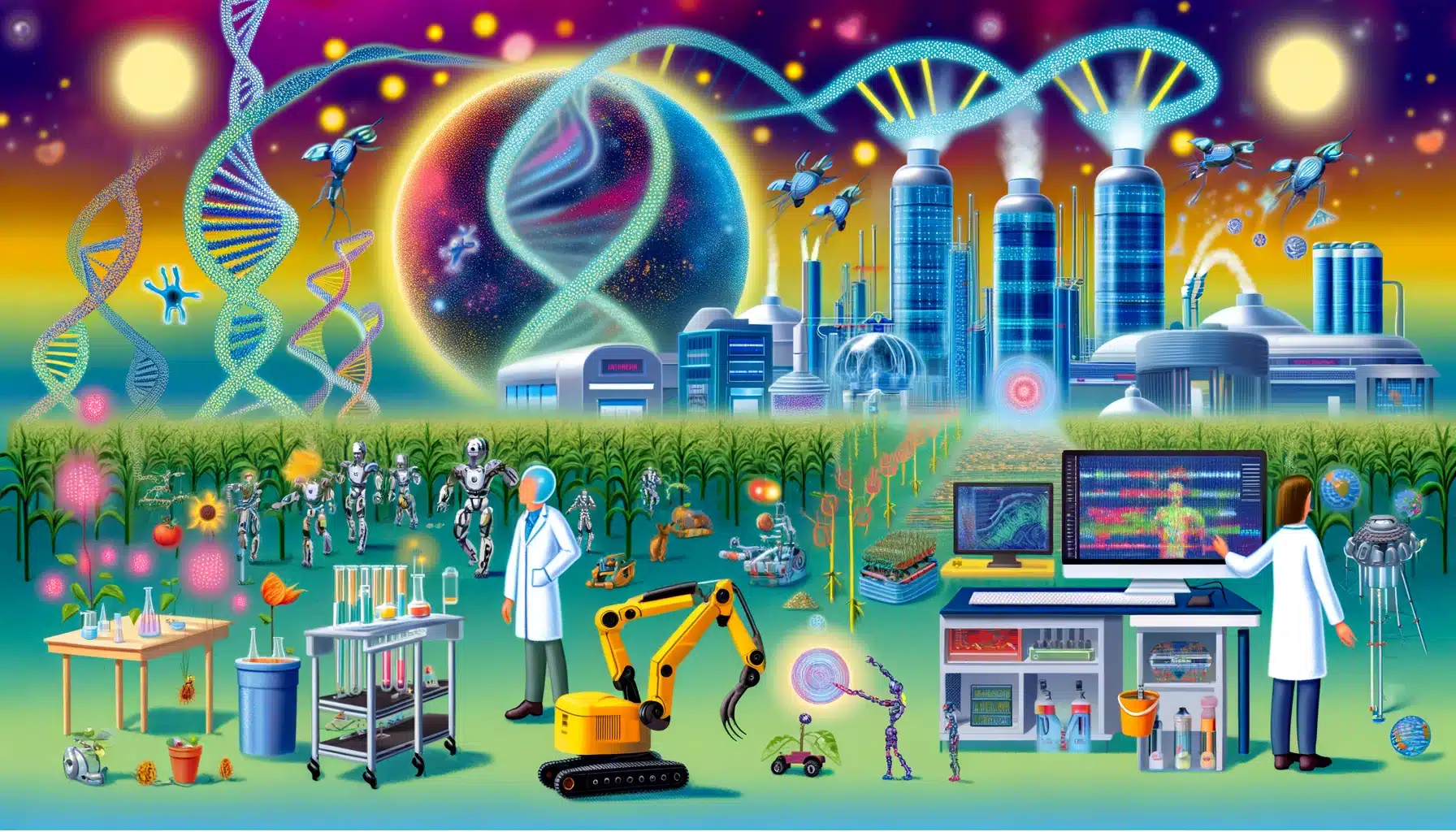Hours before Amy Webb is slated to take the stage for her keynote, her admirers are already lining up, eager to soak in every bit of wisdom from this titan of foresight, intelligence, and data mastery. In my eyes, Amy Webb stands unrivaled as the quintessential futurist of our times. Her unparalleled skills, rigorous methodology, and astute analysis truly set her apart.

Allow me to introduce her briefly: Amy Webb is a celebrated futurist, author, and the visionary founder of the Future Today Institute, a premier firm specializing in foresight and strategic planning that equips leaders and institutions to navigate complex future landscapes. Amy is acclaimed for her adeptness at predicting technology trends and evaluating their implications for the global economy, society, and the corporate world. Her analysis spans a diverse array of technological fields, from artificial intelligence and biotechnology to digital media and beyond. She has a reputation for devouring generals, government figures, and industry leaders with her morning coffee.
Technology Supercycle
From the moment she took the stage, Amy Webb had the audience spellbound with her dynamic, utterly engrossing, and straightforward approach. Having followed her work for nearly two decades, I’ve yet to see her as forthrightly declare the monumental shifts poised to upheave our societal and corporate realms.
She introduces the notion of a Technology Supercycle, a period marked by explosive technological innovation that’s set to fundamentally alter the essence of our daily existence. This supercycle, she explains, is fueled by deep and lasting changes across various domains, including global supply chains, everyday habits, global politics, and social dynamics. Central to this wave of transformation are three critical technological frontiers: artificial intelligence (AI), biotechnology, and interconnected wearable devices. These fields, according to Webb, are on the cusp of reshaping our interactions across the board, from healthcare and finance to our personal and communal engagements.
Webb dubs this phenomenon a “supercycle” to underscore the breadth and depth of this innovation wave, mirroring the expansive impact of economic supercycles known for their role in escalating commodity and asset values to new peaks. This technological supercycle, characterized by significant strides in AI, biotechnology, and wearables, isn’t just about the advancements within these areas but their synergistic effect, promising to redefine human life and industry entirely.
Yet, Webb cautions, this supercycle comes with its fair share of hurdles and pitfalls. The swift pace of technological progress, combined with the blending of distinct tech realms, introduces a host of ethical, security, and privacy dilemmas. For instance, advancements in AI and biotech invite serious contemplation on data privacy, cybersecurity, bioethics, and the just distribution of advancements. Similarly, the rise of interconnected wearables raises alarms over surveillance concerns, data misuse, and the diminishing distinction between our physical and digital identities.

As Webb outlines in the comprehensive 900-page (!) report, the impact of the Technology Supercycle on society is staggering. It holds the promise of redefining industries, enriching life quality, and addressing pressing global issues like health emergencies and environmental challenges. Nonetheless, it also necessitates a critical re-evaluation of our regulatory, ethical, and societal standards to mitigate the risks this rapid technological evolution entails.
Three Core Components:
Amy sketches three key components in more detail:
Artificial Intelligence (AI)
is a critical element within the unfolding Technology Supercycle, driving transformative changes across virtually every industry and sector. Webb highlights AI’s role in enhancing decision-making processes, automating tasks, and enabling innovations previously out of reach. She points out that both Generative AI and traditional AI technologies are at the forefront of this transformation, significantly improving data quality, computational power, and algorithm efficiency. Webb notes the emergence of self-improving AI models as a catalyst for a virtuous cycle of development, leading to increasingly intelligent and efficient systems. This progress is especially visible in the creation of AI models that provide personalized recommendations, revolutionizing virtually every single industry and sector by tailoring services and treatments to individual needs.
However, Webb also addresses energetically the challenges accompanying the widespread adoption of AI technologies. She keenly observes that entrenched business practices and old style business leaders often pose significant barriers to integrating cutting-edge AI solutions. Furthermore, Webb emphasizes the fluid state of the regulatory landscape for AI, which creates uncertainty for businesses about future regulations’ impact on AI deployment. This uncertainty, according to Webb, can deter organizations from fully embracing AI-driven changes.
A highly critical concern highlighted by Amy is the issue of bias in AI (yes: male, white and middle-aged), which she identifies as an urgent challenge requiring immediate attention to ensure fairness and equity. She points out the need for evolving AI governance to balance ethical standards and data privacy without inhibiting innovation. As AI technologies increasingly integrate into society, Webb stresses the importance of clear, adaptable, and supportive regulatory frameworks that promote the ethical use of AI… and technology leaders with the balls and drive to steer in the right direction.
Webb is convinced that AI has the potential to transform every single industry and sector, offering personalized, efficient solutions. Yet, realizing this potential, as Webb argues, necessitates navigating the intricate dynamics of innovation acceleration, strategic communication, business adaptation, acculturation and regulatory (r)evolution through collaborative efforts. Webb calls for stakeholders across the board to work together in addressing these challenges, ensuring AI’s responsible and beneficial impact on society at large.
Biotechnology
Without missing a beat, Amy Webb articulated that biotechnology, propelled by genetic engineering and CRISPR technology, is at the forefront of transforming healthcare, agriculture, and environmental conservation, offering solutions to critical global challenges. She highlights CRISPR technology’s role as a pivotal force in biotech’s progress, having achieved significant milestones like the approval of Casgevy for sickle cell disease. This, according to Webb, is not merely a medical triumph but a testament to the vast potential of precision gene editing in ushering a new era of personalized medicine. A miracle, but one we did not here from…).
Amy points out the powerful synergy between AI and biotechnology, driving advancements that are reshaping healthcare are extending their influence to agriculture and material science. This combination of AI’s analytical strengths with biotech’s innovative approaches, Webb suggests, necessitates strategic foresight from businesses and governments to navigate the evolving biotech landscape effectively.

However, Webb also warns of the challenges inherent in biotechnology’s advancement. She underscores the emergence of cyberbiosecurity threats and the ethical considerations surrounding gene-editing technologies. The need for robust security measures and clear ethical guidelines is paramount in ensuring that biotechnological innovations benefit humanity without causing unintended harm.
In response to these challenges, Webb advocates for the development of new policies that specifically address the unique concerns of the biotech field, especially considering the convergence with AI. She emphasizes the biotech sector’s capacity to address some of the most pressing global issues, such as unmet medical needs and environmental sustainability. Through leveraging biotechnological innovations, Webb sees a pathway to sustainable agricultural practices, the development of eco-friendly materials, and novel therapies for longstanding diseases.
Webb believes we can unlock biotechnology’s vast potential for societal benefit, marking a path towards a future where biotechnological innovations promote progress in alignment with ethical and sustainable principles. Time for politicians and company executives to wake up, or vacant their seats…
Interconnected Wearable Devices
Amy Webb emphasizes the growing influence of interconnected wearable devices, extending their reach beyond humans to pets and even objects, weaving them seamlessly into the fabric of our lives. This integration is fostering enhanced connectivity, personalization, and a novel tier of digital interaction. Webb points out that the fusion of interconnected wearables with Large Action Models (LAMs) and AI advancements is propelling us toward a future where technology not only complements but fundamentally enriches our daily existence. This era is hallmarked by the sophisticated integration of wearable technologies into our daily routines, offering unmatched personalized health insights and transforming our interaction with our environment.
Highlighting key innovations like smart rings, augmented reality (AR)-enabled devices, and the novel concept of “on-face” computers, Webb illustrates a stride toward a more intertwined digital and physical reality. She notes how these devices are set to redefine our interaction with the world by superimposing digital information onto our physical surroundings, thus enhancing our perception and access to information in unprecedented ways.
Looking ahead, Webb envisions wearable technologies becoming so integrated into our personal style and daily activities that they become virtually invisible, yet their impact remains significant. This integration, powered by the data generated from these wearables and analyzed through LAMs, GenAI, and AI, is set to drastically improve device efficiency and capabilities, particularly in real-time health data interpretation.

However, Webb also cautions against the challenges related to data privacy and security within this rapidly evolving landscape. The potential misuse of personal information highlights an urgent need for stringent security measures and ethical guidelines to protect users. In Webb’s view, achieving a balance between innovation and privacy, especially in integrating sophisticated AI with wearables, is crucial. Such balance is necessary to ensure the technology’s benefits are fully realized without infringing on individual rights or freedoms..
With great power, comes great responsibility
Amy Webb sees the Technology Supercycle as a pivotal era marked by groundbreaking innovations in AI, biotechnology, and interconnected wearable devices. These developments are poised to catalyze a monumental shift, reshaping every aspect of human life, from industries and economies to societal norms.
Webb outlines the supercycle’s essence as its unmatched potential for growth and innovation, offering solutions to the world’s most complex issues, including healthcare breakthroughs and societal improvements through biotechnology, AI, and wearables. Yet, she cautions, this rapid pace of innovation brings its own set of challenges, notably ethical dilemmas, privacy issues, and the need for comprehensive regulatory frameworks to ensure responsible utilization of these technologies.
Navigating this Supercycle, according to Webb, demands significant responsibility from political leaders, C-level executives, boards, and especially Chief Technology Officers (CTOs). Politicians must craft policies that both spur innovation and protect citizens. C-level executives and boards should embrace strategic foresight and adaptability. CTOs, in particular, are tasked with being evangelists and energetic drivers of change, guiding their companies through the integration of new technologies to ensure they contribute to and benefit from the Supercycle.
Webb points out that the impacts of this Supercycle are unfolding now, with immediate and long-term consequences for the workforce, businesses, and society at large. The immediate challenge for businesses lies in integrating new technologies and upskilling the workforce, whereas the long-term shifts will alter the very nature of work, organizational structures, and industry landscapes, underscoring the importance of continuous learning and adaptation.
The societal impact of the Technology Supercycle, as Webb notes, is profound. It promises significant improvements in quality of life and connectivity but also poses risks such as job displacement and a widening digital divide. These considerations underscore the need for inclusive and equitable strategies to ensure the broad distribution of technological benefits.
In conclusion, Webb articulates that the Technology Supercycle marks a critical moment in human history, characterized by swift technological advancements with extensive ramifications. She asserts that successfully navigating this era requires collective leadership effort to address challenges, harness opportunities, and craft a future where technology enhances human potential in alignment with ethical standards and societal well-being…
I must confess, Amy Webb’s insights struck a chord with me—loud and clear. Her portrayal of the impending changes convinced me beyond doubt. The future she sketched out—a new world navigated by the compass of technology and ethics—seems much closer to reality than I had initially anticipated…
Amy Webb’s 979 slides : https://futuretodayinstitute.com/wp-content/uploads/2024/03/TR2024_Full-Report_FINAL_LINKED.pdf












